Book contents
- Sex Offender Registration and Community Notification Laws: An Empirical Evaluation
- Sex Offender Registration and Community Notification Laws
- Copyright page
- Contents
- Contributors
- Preface
- Acknowledgments
- 1 Origins and Evolution
- 2 Variations in the Structure and Operation of SORN Systems
- 3 Registries and Registrants:
- 4 Law Enforcement and SORN
- 5 The Public and SORN Laws
- 6 The Ancillary Consequences of SORN
- 7 Offenders and SORN Laws
- 8 Integrating the Etiology of Sexual Offending into Evidence-Based Policy and Practices
- 9 Juvenile Registration and Notification Are Failed Policies That Must End
- Conclusion
- Index
- References
3 - Registries and Registrants:
Research on the Composition of Registries
Published online by Cambridge University Press: 11 June 2021
- Sex Offender Registration and Community Notification Laws: An Empirical Evaluation
- Sex Offender Registration and Community Notification Laws
- Copyright page
- Contents
- Contributors
- Preface
- Acknowledgments
- 1 Origins and Evolution
- 2 Variations in the Structure and Operation of SORN Systems
- 3 Registries and Registrants:
- 4 Law Enforcement and SORN
- 5 The Public and SORN Laws
- 6 The Ancillary Consequences of SORN
- 7 Offenders and SORN Laws
- 8 Integrating the Etiology of Sexual Offending into Evidence-Based Policy and Practices
- 9 Juvenile Registration and Notification Are Failed Policies That Must End
- Conclusion
- Index
- References
Summary
Chapter 3 analyzes the demographic makeup and composition of state sex offender registries. The data reject the popular narratives of incomplete registries filled with dangerous individuals. The chapter begins by investigating the widely reported counts of registered individuals from the National Center for Missing and Exploited Children (NCMEC). While NCMEC reports that there are nearly one million registrants nationwide, no true national registry exists to confirm this claim. Further, independent studies indicate that many registrants simply do not live in their listed community – they may be incarcerated, committed, deported, or deceased. Additionally, the data refute common arguments that registries are systematically incomplete with regard to “missing” registrants. The chapter next examines how registries reflect broader racial dynamics. The typical registrant is middle-aged and white. However, registries are disproportionately black, and black registrants are overclassified with respect to recidivism risk. Finally, the chapter dissects the technical and data challenges affecting registries. While intra-registry duplicates plague few jurisdictions, many registries contain individuals present on other states’ registries. This chapter contends that policymakers should account for these deficiencies when considering sex offender policy.
Keywords
- Type
- Chapter
- Information
- Sex Offender Registration and Community Notification LawsAn Empirical Evaluation, pp. 35 - 47Publisher: Cambridge University PressPrint publication year: 2021



